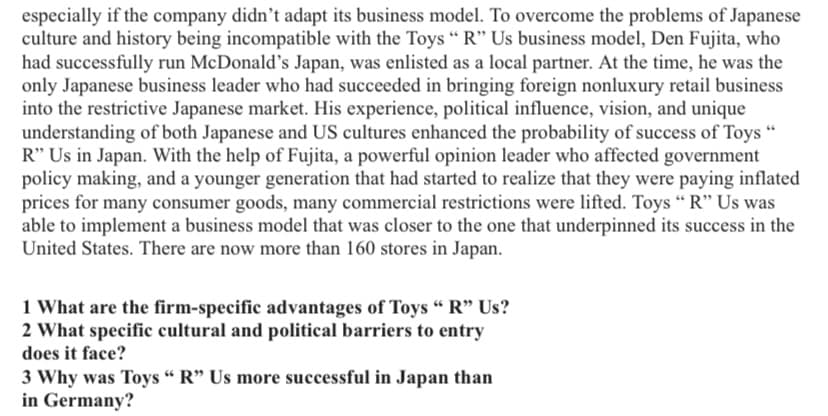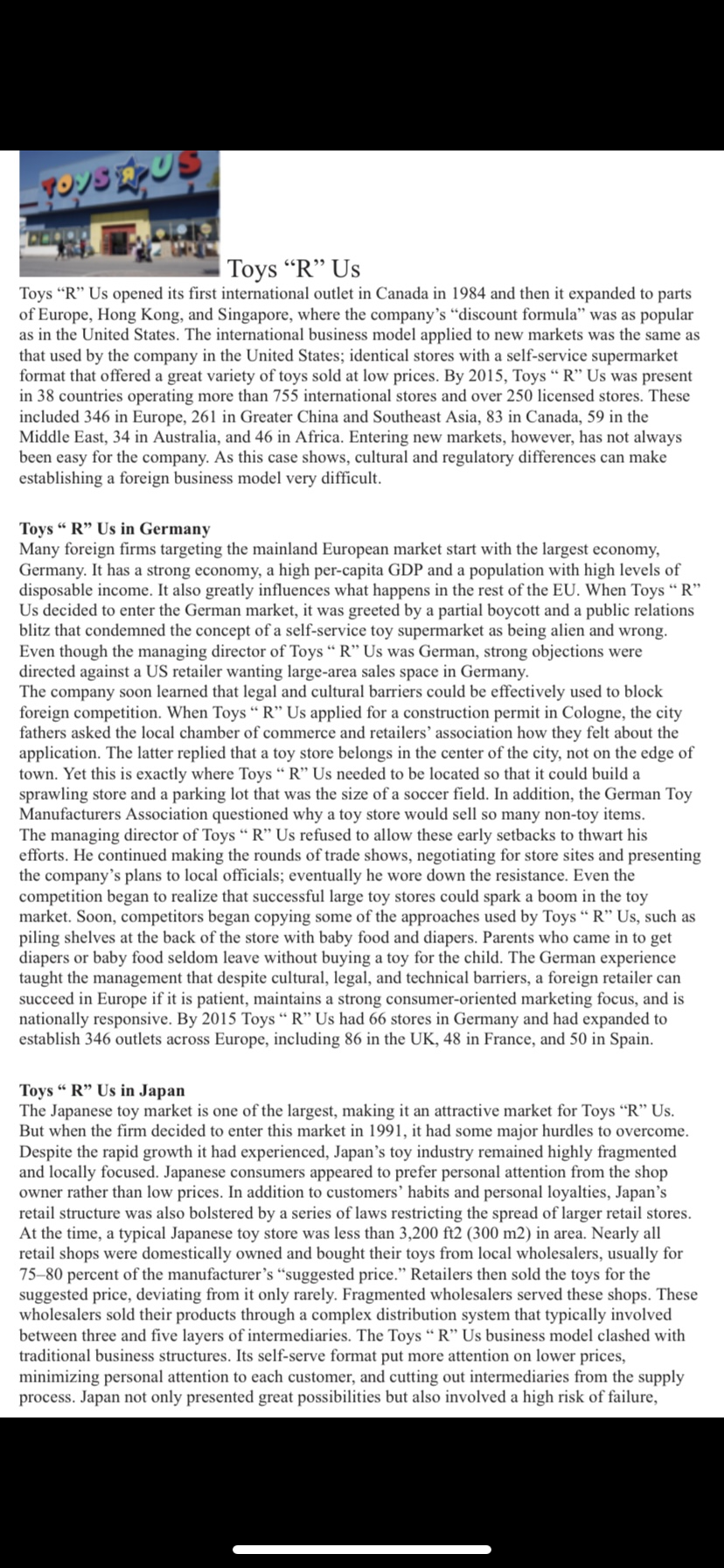1 What are the firm-specific advantages of Toys “ R" Us? 2 What specific cultural and political barriers to entry does it face? 3 Why was Toys " R" Us more successful in Japan than in Germany?
1 What are the firm-specific advantages of Toys “ R" Us? 2 What specific cultural and political barriers to entry does it face? 3 Why was Toys " R" Us more successful in Japan than in Germany?
Chapter1: Taking Risks And Making Profits Within The Dynamic Business Environment
Section: Chapter Questions
Problem 1CE
Related questions
Question
Here in case study 3 questions please help me

Transcribed Image Text:especially if the company didn't adapt its business model. To overcome the problems of Japanese
culture and history being incompatible with the Toys " R" Us business model, Den Fujita, who
had successfully run McDonald's Japan, was enlisted as a local partner. At the time, he was the
only Japanese business leader who had succeeded in bringing foreign nonluxury retail business
into the restrictive Japanese market. His experience, political influence, vision, and unique
understanding of both Japanese and US cultures enhanced the probability of success of Toys "
R" Us in Japan. With the help of Fujita, a powerful opinion leader who affected government
policy making, and a younger generation that had started to realize that they were paying inflated
prices for many consumer goods, many commercial restrictions were lifted. Toys “ R" Us was
able to implement a business model that was closer to the one that underpinned its success in the
United States. There are now more than 160 stores in Japan.
1 What are the firm-specific advantages of Toys "“ R" Us?
2 What specific cultural and political barriers to entry
does it face?
3 Why was Toys “ R" Us more successful in Japan than
in Germany?

Transcribed Image Text:| Toys "R" Us
Toys "R" Us opened its first international outlet in Canada in 1984 and then it expanded to parts
of Europe, Hong Kong, and Singapore, where the company's "discount formula" was as popular
as in the United States. The international business model applied to new markets was the same as
that used by the company in the United States; identical stores with a self-service supermarket
format that offered a great variety of toys sold at low prices. By 2015, Toys “ R" Us was present
in 38 countries operating more than 755 international stores and over 250 licensed stores. These
included 346 in Europe, 261 in Greater China and Southeast Asia, 83 in Canada, 59 in the
Middle East, 34 in Australia, and 46 in Africa. Entering new markets, however, has not always
been easy for the company. As this case shows, cultural and regulatory differences can make
establishing a foreign business model very difficult.
Toys " R" Us in Germany
Many foreign firms targeting the mainland European market start with the largest economy,
Germany. It has a strong economy, a high per-capita GDP and a population with high levels of
disposable income. It also greatly influences what happens in the rest of the EU. When Toys "R"
Us decided to enter the German market, it was greeted by a partial boycott and a public relations
blitz that condemned the concept of a self-service toy supermarket as being alien and wrong.
Even though the managing director of Toys " R" Us was German, strong objections were
directed against a US retailer wanting large-area sales space in Germany.
The company soon learned that legal and cultural barriers could be effectively used to block
foreign competition. When Toys " R" Us applied for a construction permit in Cologne, the city
fathers asked the local chamber of commerce and retailers' association how they felt about the
application. The latter replied that a toy store belongs in the center of the city, not on the edge of
town. Yet this is exactly where Toys “ R" Us needed to be located so that it could build a
sprawling store and a parking lot that was the size of a soccer field. In addition, the German Toy
Manufacturers Association questioned why a toy store would sell so many non-toy items.
The managing director of Toys " R" Us refused to allow these early setbacks to thwart his
efforts. He continued making the rounds of trade shows, negotiating for store sites and presenting
the company's plans to local officials; eventually he wore down the resistance. Even the
competition began to realize that successful large toy stores could spark a boom in the toy
market. Soon, competitors began copying some of the approaches used by Toys " R" Us, such as
piling shelves at the back of the store with baby food and diapers. Parents who came in to get
diapers or baby food seldom leave without buying a toy for the child. The German experience
taught the management that despite cultural, legal, and technical barriers, a foreign retailer can
succeed in Europe if it is patient, maintains a strong consumer-oriented marketing focus, and is
nationally responsive. By 2015 Toys “ R" Us had 66 stores in Germany and had expanded to
establish 346 outlets across Europe, including 86 in the UK, 48 in France, and 50 in Spain.
Toys " R" Us in Japan
The Japanese toy market is one of the largest, making it an attractive market for Toys “R" Us.
But when the firm decided to enter this market in 1991, it had some major hurdles to overcome.
Despite the rapid growth it had experienced, Japan's toy industry remained highly fragmented
and locally focused. Japanese consumers appeared to prefer personal attention from the shop
owner rather than low prices. In addition to customers' habits and personal loyalties, Japan's
retail structure was also bolstered by a series of laws restricting the spread of larger retail stores.
At the time, a typical Japanese toy store was less than 3,200 ft2 (300 m2) in area. Nearly all
retail shops were domestically owned and bought their toys from local wholesalers, usually for
75-80 percent of the manufacturer's "suggested price." Retailers then sold the toys for the
suggested price, deviating from it only rarely. Fragmented wholesalers served these shops. These
wholesalers sold their products through a complex distribution system that typically involved
between three and five layers of intermediaries. The Toys "R" Us business model clashed with
traditional business structures. Its self-serve format put more attention on lower prices,
minimizing personal attention to each customer, and cutting out intermediaries from the supply
process. Japan not only presented great possibilities but also involved a high risk of failure,
Expert Solution
This question has been solved!
Explore an expertly crafted, step-by-step solution for a thorough understanding of key concepts.
This is a popular solution!
Trending now
This is a popular solution!
Step by step
Solved in 2 steps

Knowledge Booster
Learn more about
Need a deep-dive on the concept behind this application? Look no further. Learn more about this topic, management and related others by exploring similar questions and additional content below.Recommended textbooks for you

Understanding Business
Management
ISBN:
9781259929434
Author:
William Nickels
Publisher:
McGraw-Hill Education

Management (14th Edition)
Management
ISBN:
9780134527604
Author:
Stephen P. Robbins, Mary A. Coulter
Publisher:
PEARSON

Spreadsheet Modeling & Decision Analysis: A Pract…
Management
ISBN:
9781305947412
Author:
Cliff Ragsdale
Publisher:
Cengage Learning

Understanding Business
Management
ISBN:
9781259929434
Author:
William Nickels
Publisher:
McGraw-Hill Education

Management (14th Edition)
Management
ISBN:
9780134527604
Author:
Stephen P. Robbins, Mary A. Coulter
Publisher:
PEARSON

Spreadsheet Modeling & Decision Analysis: A Pract…
Management
ISBN:
9781305947412
Author:
Cliff Ragsdale
Publisher:
Cengage Learning

Management Information Systems: Managing The Digi…
Management
ISBN:
9780135191798
Author:
Kenneth C. Laudon, Jane P. Laudon
Publisher:
PEARSON

Business Essentials (12th Edition) (What's New in…
Management
ISBN:
9780134728391
Author:
Ronald J. Ebert, Ricky W. Griffin
Publisher:
PEARSON

Fundamentals of Management (10th Edition)
Management
ISBN:
9780134237473
Author:
Stephen P. Robbins, Mary A. Coulter, David A. De Cenzo
Publisher:
PEARSON